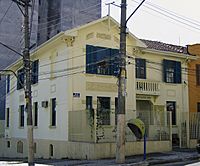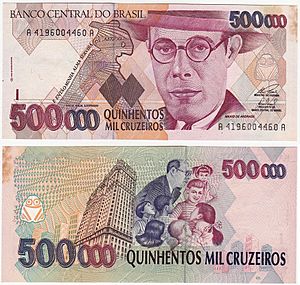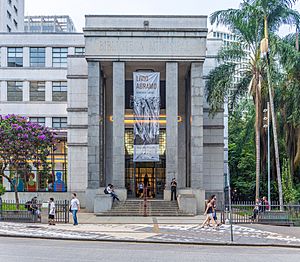Mário de Andrade facts for kids
Quick facts for kids
Mário de Andrade
|
|
|---|---|
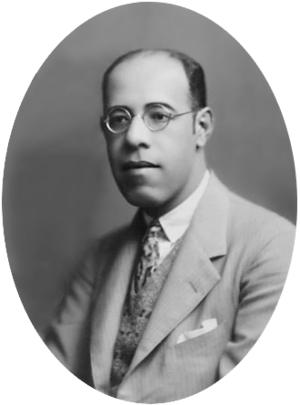
Mário de Andrade at age 35, 1928
|
|
| Born | Mário Raul de Moraes Andrade October 9, 1893 São Paulo, Brazil |
| Died | February 25, 1945 (aged 51) São Paulo, Brazil |
| Occupation | Poet, novelist, musicologist, art historian, critic and photographer |
| Literary movement | Modernism |
| Notable works | Macunaíma |
Mário Raul de Morais Andrade (October 9, 1893 – February 25, 1945) was a famous Brazilian poet, novelist, expert in music, art and critic, and a photographer. He wrote one of the first and most important collections of modern Brazilian poetry, Paulicéia Desvairada (which means Hallucinated City), published in 1922. He had a huge impact on modern Brazilian literature. As a scholar and writer, he was one of the first to study music from different cultures (a field called ethnomusicology), and his influence spread far beyond Brazil.
Andrade was a key figure in the avant-garde movement in São Paulo for twenty years. He trained as a musician and was best known as a poet and novelist. Andrade was involved in almost every type of art and study connected with São Paulo modernism. His photographs and essays on many topics, from history to literature and music, were widely published. He was the main organizer behind the Week of Modern Art in 1922. This event changed both literature and visual arts in Brazil. He was also part of the "Group of Five" avant-garde artists. The ideas from the Week of Modern Art were further explored in his poetry book Pauliceia Desvairada.
After working as a music professor and newspaper writer, he published his great novel, Macunaíma, in 1928. He continued to work on Brazilian folk music, poetry, and other interests. This work was often interrupted by his changing relationship with the Brazilian government. Towards the end of his life, he became the first director of São Paulo's Department of Culture. This made official his long-standing role in bringing artistic modernity to the city and the nation.
Contents
Early Life and Studies
Andrade was born in São Paulo and lived there almost his entire life. As a child, he was a child prodigy at the piano. He later studied at the Music and Drama Conservatory of São Paulo. His formal education was only in music. However, he also studied history, art, and especially poetry on his own. Andrade knew French well and read works by Rimbaud and other important Symbolist writers. He wrote poetry throughout his music studies, but he only thought about it as a career when he could no longer be a professional pianist.
In 1913, his 14-year-old brother Renato died suddenly during a football game. Andrade left the Conservatory to stay at Araraquara, where his family had a farm. When he returned, his hands sometimes trembled when he played the piano. Even though he earned a degree in piano, he did not give concerts. Instead, he started studying singing and music theory to become a music professor. At the same time, he began writing more seriously. In 1917, the year he graduated, he published his first poetry book, Há uma Gota de Sangue em Cada Poema (There is a drop of blood in each poem). He used the pseudonym Mário Sobral. The book showed hints of Andrade's growing sense of a unique Brazilian identity. However, it was still very much like earlier European, especially French, poetry.
His first book did not have a huge impact, so Andrade started writing about more topics. He left São Paulo for the countryside. He began a lifelong activity: carefully documenting the history, people, culture, and especially music of rural Brazil. This included areas in São Paulo state and wilder regions to the northeast. He published essays in São Paulo magazines, sometimes with his own photographs. But mainly, he collected a lot of information about Brazilian life and folklore. Between these trips, Andrade taught piano at the Conservatory and became a professor there in 1921.
The Week of Modern Art
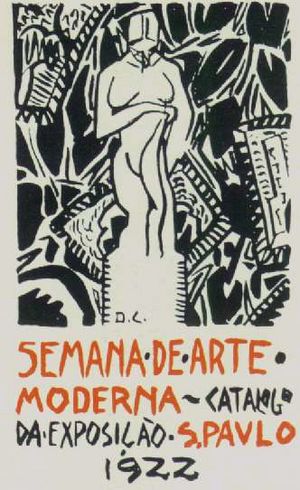
While on these folklore trips, Andrade became friends with young artists and writers in São Paulo. Like him, they knew about the growing modernist movement in Europe. Several of them later became known as the Grupo dos Cinco (the Group of Five). This group included Andrade, poets Oswald de Andrade (no relation) and Menotti del Picchia, and artists Tarsila do Amaral and Anita Malfatti.
Andrade worked on his book, titled Paulicéia Desvairada in Portuguese, for two years. These poems were very different from his earlier formal and abstract work. The lines of poetry varied greatly in length and sentence structure. They mostly contained impressionistic and fragmented descriptions mixed with seemingly overheard, disconnected bits of speech in São Paulo dialect. The speaker in the poems often seemed overwhelmed by the constant interruptions of dialogue.
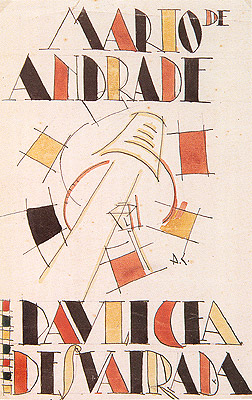
In 1922, while getting Paulicéia Desvairada ready for publishing, Andrade worked with Malfatti and Oswald de Andrade. They created an event to show their work to the public: the Semana de Arte Moderna (Week of Modern Art). The Semana included art exhibitions by Malfatti and others, readings, and talks about art, music, and literature. Andrade was the main organizer and central figure of the event. It was met with doubt but had many attendees. He gave talks on modernism and his work in Brazilian folk music. He also read his "Extremely Interesting Preface." As the main event of the Semana, he read from Paulicéia Desvairada. The poems used free verse and everyday São Paulo expressions. While similar to European modernist poems, they were completely new to Brazilians. The reading was met with loud jeers, but Andrade kept going. He later found out that many in the audience found it life-changing. It is often called the most important event in modern Brazilian literature.
The Group of Five continued to work together in the 1920s. Their reputations grew, and people became less hostile to their work. However, the group eventually broke apart. Andrade and Oswald de Andrade had a serious public disagreement in 1929. New groups formed from the original one. In the end, many different modernist movements could trace their beginnings back to the Week of Modern Art.
Exploring Brazil: "The Apprentice Tourist"
Throughout the 1920s, Andrade kept traveling in Brazil. He studied the culture and folklore of the country's interior. He began to develop a complex idea about the social meaning of folk music. This idea was both nationalistic and very personal. Andrade's main topic was the connection between "artistic" music and the music of the streets and countryside. This included both Afro-Brazilian and Amerindian styles. His work was debated because it formally discussed dance music and folk music. These debates were made stronger by Andrade's writing style, which was both poetic and argumentative.
His travels through Brazil became more than just research trips. In 1927, he started writing a travelogue called "The apprentice tourist" for the newspaper O Diario Nacional. This column introduced people from the cities to indigenous Brazil. At the same time, it promoted Andrade's own work. Many of Andrade's photographs were published with the column, showing the landscape and people. Sometimes, Andrade himself appeared in them, usually as a shadow in the landscape. His photographs helped his modernist project and his own work, while also recording folklore.
Andrade continued taking photographs throughout his career. However, the images from the 1920s make up most of his important work, especially the 1927 series. He was very interested in how photographs could capture or bring back the past. He saw this power as very personal. In many of his images, figures are shadowed, blurry, or almost invisible. This type of portraiture became a kind of modernist sublime for Andrade.
Macunaíma: A Brazilian Hero
At the same time, Andrade became very familiar with the dialects and cultures of large parts of Brazil. He started using the speech-patterned writing style he developed for his Hallucinated City poems in his prose fiction. He wrote two novels during this time using these techniques. The first, Love, Intransitive Verb, was mostly an experiment with form. The second, written shortly after and published in 1928, was Macunaíma. This novel is about a man (whose subtitle is "The hero without a character") from an indigenous tribe. He comes to São Paulo, learns its languages (both Portuguese and Brazilian, the novel says), and then returns home. The novel's style mixes vivid descriptions of both jungle and city with sudden shifts into fantasy. This style would later be called magical realism.
Macunaíma, once seen by some critics as just historically important, is now recognized as a modernist masterpiece. Its challenges are part of its unique aesthetic. Andrade is a national cultural icon in Brazil; his face has even appeared on Brazilian money. A film of Macunaíma was made in 1969 by Brazilian director Joaquim Pedro de Andrade. This film updated Andrade's story to the 1960s and moved it to Rio de Janeiro. The film was re-released internationally in 2009.
Later Life and Music Research
Andrade was not directly affected by the Revolution of 1930, when Getúlio Vargas took strong control of the government. However, Andrade belonged to the wealthy class that the Revolution aimed to change. His job prospects became worse under the Vargas government. He was able to stay at the Conservatory, where he was now in charge of Music History and Aesthetics. With this title, he became a national expert on music history. His research shifted from his personal interests of the 1920s to writing textbooks and timelines. He continued to document rural folk music. During the 1930s, he made a huge collection of recordings of songs and other music from the interior. These recordings were very thorough, chosen for their completeness rather than artistic quality. They included context, related folktales, and other non-musical sounds. Andrade's methods were important in developing ethnomusicology in Brazil. They came before similar work done elsewhere, like the well-known recordings of Alan Lomax. He is credited with creating the word "popularesque." He defined it as imitations of Brazilian folk music by educated city musicians. This word is still used today when discussing Brazilian music.
In 1935, during an unstable time in Vargas's government, Andrade and writer and archaeologist Paulo Duarte were able to create a unified São Paulo Department of Culture. Duarte had wanted to promote cultural research and activities in the city through a government agency for many years. Andrade was named its first director. The Department of Culture had a wide range of responsibilities. It oversaw cultural and population research, the building of parks and playgrounds, and a large publishing section. Andrade approached the position with his usual ambition. He used it to expand his work in folklore and folk music. He also organized many performances, lectures, and exhibitions. He moved his collection of recordings to the Department. Expanding and improving this collection became one of the Department's main jobs, overseen by Andrade's former student, Oneyda Alvarenga. This collection, called the Discoteca Municipal, was "probably the largest and best-organized in the entire hemisphere."
At the same time, Andrade was improving his ideas about music. He tried to combine his research into a general theory. Always concerned with modernism's need to break from the past, he made a difference between classical music from 18th and 19th-century Europe and what he called the music of the future. This future music would be based on both modernist changes in musical form and an understanding of folk and popular music. He said that past music was thought of in terms of space. This included counterpoint, with its multiple voices arranged vertically, or symphonic forms, where the main voice is usually placed above a complex accompaniment. Future music, he believed, would be arranged in time rather than space: "moment by moment." This temporal music would be inspired not by "contemplative remembrance," but by the deep longing or desire expressed by the Portuguese word saudade.
Through his position at the Department of Culture during this period, he helped Dina Lévi-Strauss and her husband, Claude Lévi-Strauss, with films they were making based on their research in Mato Grosso and Rondônia.
Andrade's position at the Department of Culture was suddenly taken away in 1937. This happened when Vargas returned to power and Duarte was sent away from the country. In 1938, Andrade moved to Rio de Janeiro to take a job at the Universidade Federal do Rio de Janeiro. While there, he directed the Congress of National Musical Language, a major conference on folklore and folk music. He returned to São Paulo in 1941, where he worked on a collected edition of his poetry.
Andrade's final project was a long poem called "Meditação Sôbre o Tietê." This work is complex and was first seen by critics as "without meaning." However, recent studies have been more positive about it. One critic, David T Haberly, compared it to William Carlos Williams's Paterson. Like Paterson, it is a poem about a city. The "Meditação" focuses on the Tietê River, which flows through São Paulo. The poem is both a summary of Andrade's career, commenting on poems written long ago, and a love poem to the river and the city itself. The poem hints at a larger international context, comparing the river to the Tagus in Lisbon and the Seine in Paris. At the same time, the poem connects Andrade's voice and the river with "banzeiro." This is a word from Afro-Brazilian music that describes music that can unite people and rivers. The poem is the clear and final statement of Andrade's ambition and his love for his country.
Death and Legacy
Andrade died at his home in São Paulo from a heart attack on February 25, 1945. He was 51 years old. Because of his difficult relationship with the Vargas government, the first official reaction to his career was quiet. However, the publication of his Complete Poems in 1955 (the year after Vargas's death) marked the beginning of Andrade being recognized as one of Brazil's cultural heroes. On February 15, 1960, the municipal library of São Paulo was renamed the Biblioteca Mário de Andrade in his honor.
See also
 In Spanish: Mário de Andrade para niños
In Spanish: Mário de Andrade para niños


